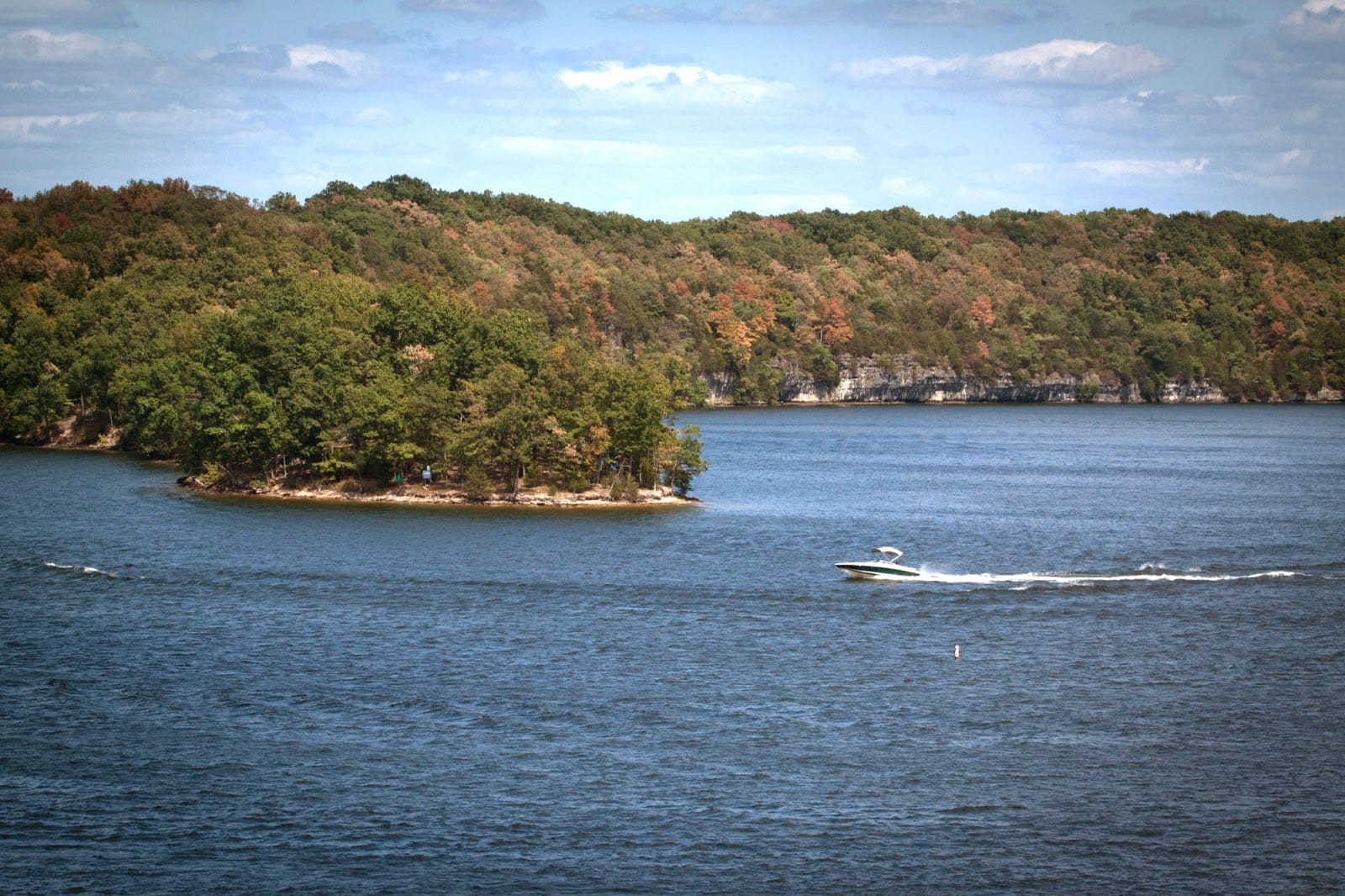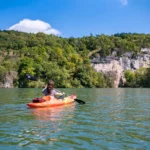Get ready to plunge into the captivating story of Lake of the Ozarks, the biggest lake in Missouri. We’ll dive deep into how it came to be, from its humble beginnings as a web of rivers to the stunning reservoir it is today. Along the way, we’ll explore its crucial role in providing electricity, boosting the local economy, and creating a haven for outdoor enthusiasts. Plus, we’ll delve into the ongoing efforts to keep this watery gem thriving in an ever-changing world. So grab a seat and let’s uncover the fascinating history and impact of this hydroelectric marvel.
Is Lake of the Ozarks Man Made?
Nestled within the heart of the majestic Ozark Mountains, Lake of the Ozarks stands out as a shimmering gem, a testament to human ingenuity. But the question that often arises is: is this vast body of water a work of nature or the handiwork of humans?
The answer lies in history’s pages, way back in 1929. It was then that the ambitious construction of the Bagnell Dam forever changed the landscape of the Osage River, giving birth to the magnificent Lake of the Ozarks.
The colossal dam, with its towering concrete frame, transformed the river’s flow, creating a sprawling reservoir that would forever leave its mark on the region. This feat of engineering not only paved the way for hydropower development but also laid the foundation for a burgeoning tourist industry.
Today, Lake of the Ozarks has become a vibrant hub for recreation, offering an array of activities that cater to every taste. From the thrill of boating and fishing to the exhilaration of water sports, the lake provides endless opportunities for adventure and relaxation.
As you bask in the serene beauty of Lake of the Ozarks, take a moment to appreciate the paradox that lies beneath its calm surface. It is a place where the imprint of human ambition harmoniously intersects with the splendor of nature. The lake serves as a reminder that our interactions with the environment can create enduring legacies, shaping both our lives and the landscapes we inhabit.
Do you know that the Lake of the Ozarks is actually man-made? Check This Out
The Creation of Lake of the Ozarks: A Hydroelectric Marvel in the Ozarks
Nestled amidst the breathtaking Ozark Mountains, Lake of the Ozarks is a vast, man-made lake that stands as a testament to human ingenuity and the harnessing of water’s immense power. Its creation in the early 20th century forever transformed the landscape and the lives of those living in the region, serving as a crucial electricity source and a thriving recreational paradise.
How Lake of the Ozarks Came to Be
The creation of Lake of the Ozarks was a monumental endeavor that began with the construction of the Bagnell Dam on the Osage River. Over 20,000 workers labored day and night from 1929 to 1931, wielding concrete and steel to create a colossal barrier that would hold back the mighty river’s waters. The result was a vast lake, the largest of its kind in the United States at the time, stretching for miles and teeming with life.
The Power of Water
The primary purpose of the Bagnell Dam was to harness the power of water to generate electricity. In an era when reliable energy was a precious commodity, Lake of the Ozarks became a vital lifeline for St. Louis and surrounding areas. The dam’s turbines churned tirelessly, converting the river’s momentum into electricity that illuminated homes, powered factories, and propelled progress.
A Recreational Paradise Emerges
While the lake’s initial purpose was to generate power, its natural beauty and recreational potential gradually became apparent. Fishing camps popped up along the glistening shores, inviting anglers to cast their lines in pursuit of trophy catches. Gradually, a thriving tourism industry blossomed, fueled by the lake’s crystal-clear waters, pristine beaches, and countless opportunities for boating, swimming, and other outdoor adventures.
Lake of the Ozarks Today
Today, Lake of the Ozarks is a multifaceted jewel that offers something for everyone. It remains a significant hydroelectric power source, providing clean and renewable energy to the region. However, its true allure lies in its recreational wonders. The lake is a popular destination for fishing, boating, swimming, and simply soaking up the beauty of the surrounding Ozarks. It has also become a hub for vacation homes, resorts, and other tourism-related businesses, creating a vibrant economic ecosystem.
A Legacy of Innovation and Recreation
The creation of Lake of the Ozarks stands as a testament to the ingenuity and resourcefulness of humanity. It is a reminder of the power of water to not only generate energy but also transform landscapes and enrich lives. Today, the lake continues to be a source of pride for the region, offering endless opportunities for recreation, relaxation, and a profound appreciation for the delicate balance between human innovation and the natural world.
Lake of the Ozarks: A Man-Made Gem that Drives the Heart of Missouri
Lake of the Ozarks, a sprawling playground tucked away in the Ozark Mountains, isn’t just a body of water—it’s a vibrant lifeline that’s been pumping economic and recreational vitality into South-Central Missouri for decades.
A Reservoir of Opportunity
When Bagnell Dam was built in the 1930s, it created this incredible lake that’s turned into a major tourist draw. People come from all over to splash around in its sparkling waters, cast their lines for fish, and soak up the sun on its sandy beaches. The lake’s proximity to bustling cities like St. Louis and Kansas City has only added to its popularity, bringing visitors and all the economic benefits that come with them.
A Paradise for the Adventure-Seeker
But the lake’s not just a cash cow—it’s also an adventure-lover’s dream. Its crystal-clear waters are perfect for swimming, snorkeling, and diving. The coves and inlets beckon you to explore them on a kayak or paddleboard. And the campgrounds and resorts that dot the shoreline offer plenty of ways to relax and rejuvenate after a day of splashing around.
A Natural Gem with a Purpose
The Lake of the Ozarks isn’t just a pretty face—it also serves a vital environmental role. Its huge surface area provides a thriving habitat for all kinds of fish and wildlife. Plus, by controlling the flow of water, the lake has helped prevent flooding in the Osage River basin.
Safeguarding a Precious Resource
Keeping Lake of the Ozarks healthy and happy is like protecting a priceless treasure. Ameren Missouri, the company that runs the dam, takes this responsibility seriously, carefully managing water levels and working to protect the lake’s ecosystem. Locals and visitors alike are also doing their part, fighting invasive species and promoting responsible boating practices.
A Legacy to Treasure
Lake of the Ozarks is more than just a lake—it’s a lifeline for the people and wildlife of South-Central Missouri. Whether you’re a thrill-seeking adventurer, a nature enthusiast, or simply someone looking to escape the daily grind, this man-made wonder has something to offer everyone. And by working together, we can ensure that Lake of the Ozarks continues to be a vibrant and thriving asset for generations to come.
Balancing Nature and Development: The Environmental Impact of Lake of the Ozarks
Nestled amidst the verdant hills of Missouri, Lake of the Ozarks is a testament to the interplay between human ambition and the natural world. Born from the construction of the Bagnell Dam in the 1920s, the lake has had a profound impact on both the environment and the surrounding communities.
The Dam’s Legacy: Environmental Transformation
The dam’s construction marked a turning point in the history of the Osage River. Once a meandering waterway, the river was transformed into a vast reservoir. This alteration had significant consequences for the local ecosystem. Wetlands vanished, biodiversity declined, and the natural flow of the river was disrupted.
Balancing Act: Preserving and Exploiting
Despite these environmental concerns, Lake of the Ozarks has also brought undeniable benefits. It protects communities from flooding, provides recreational opportunities for millions of tourists, and serves as a vital water source. Striking a balance between preserving the lake’s natural heritage and supporting economic growth remains an ongoing challenge.
Water Level Management and Invasive Species
Managing water levels is crucial for maintaining the ecological health of the lake. Fluctuating levels can stress aquatic organisms and disrupt the ecosystem. Invasive species, such as Asian carp, pose another threat to the lake’s biodiversity. Invasive species compete with native species for resources and can disrupt ecological balance.
Sustainable Development and the Visitor Economy
Sustaining the economic benefits provided by Lake of the Ozarks while minimizing its environmental footprint requires responsible development practices. Limiting the construction of shoreline structures and promoting eco-friendly tourism can help protect the lake’s natural beauty and ensure its long-term viability.
Table: Balancing Nature and Development at Lake of the Ozarks
| Environmental Issue | Mitigation Strategies |
|---|---|
| Loss of Wetlands | Protection and restoration of wetlands |
| Reduced Biodiversity | Habitat creation and invasive species control |
| Altered Water Flow Patterns | Water level management and flow restoration |
Key Takeaways:
- The creation of Lake of the Ozarks has had both positive and negative environmental impacts.
- Balancing economic growth with environmental preservation is a constant challenge.
- Water level management, invasive species control, and sustainable development practices are essential for the lake’s long-term health.
FAQ
Q1: Was Lake of the Ozarks naturally formed or man-made?
A1: Lake of the Ozarks is a man-made reservoir created by the construction of the Bagnell Dam on the Osage River in 1929.
Q2: What was the primary purpose of creating Lake of the Ozarks?
A2: The lake was initially designed to provide hydroelectric power for the Union Electric Company. However, it has since become a popular tourist destination and a vital economic driver for south-central Missouri.
Q3: How has Lake of the Ozarks impacted the local environment?
A3: The creation of the lake has had both positive and negative environmental effects. It has provided a habitat for various aquatic species and increased recreational opportunities. However, it has also altered the flow of the Osage River and led to changes in the surrounding ecosystem.
Q4: What measures are being taken to ensure the long-term sustainability of Lake of the Ozarks?
A4: Water conservation practices, watershed management, and monitoring programs are implemented to maintain the lake’s water quality and ecological health. Sustainable development strategies are also being explored to balance economic growth with environmental protection.
Q5: What recreational opportunities are available at Lake of the Ozarks?
A5: The lake offers a wide range of recreational activities, including boating, fishing, swimming, camping, and hiking. It is a popular destination for tourists and locals alike, contributing to the region’s economy through tourism and outdoor recreation.
- Senior at What Age: Benefits & Eligibility Guide - March 29, 2025
- Unlocking Senior Benefits: How Old is a Senior? Your Complete Guide - March 29, 2025
- Master Russian Politeness:A Guide to Saying Please - March 29, 2025
















